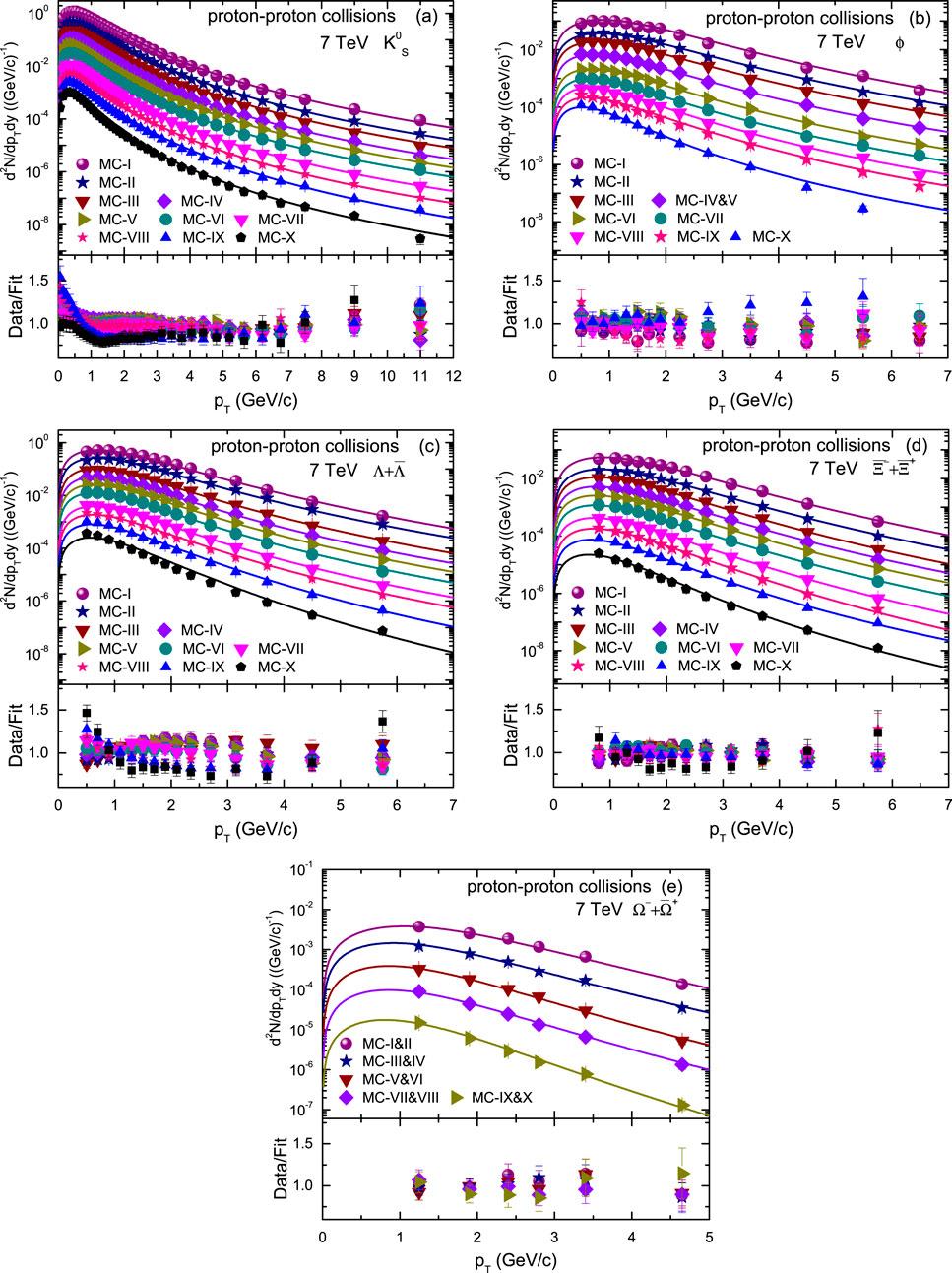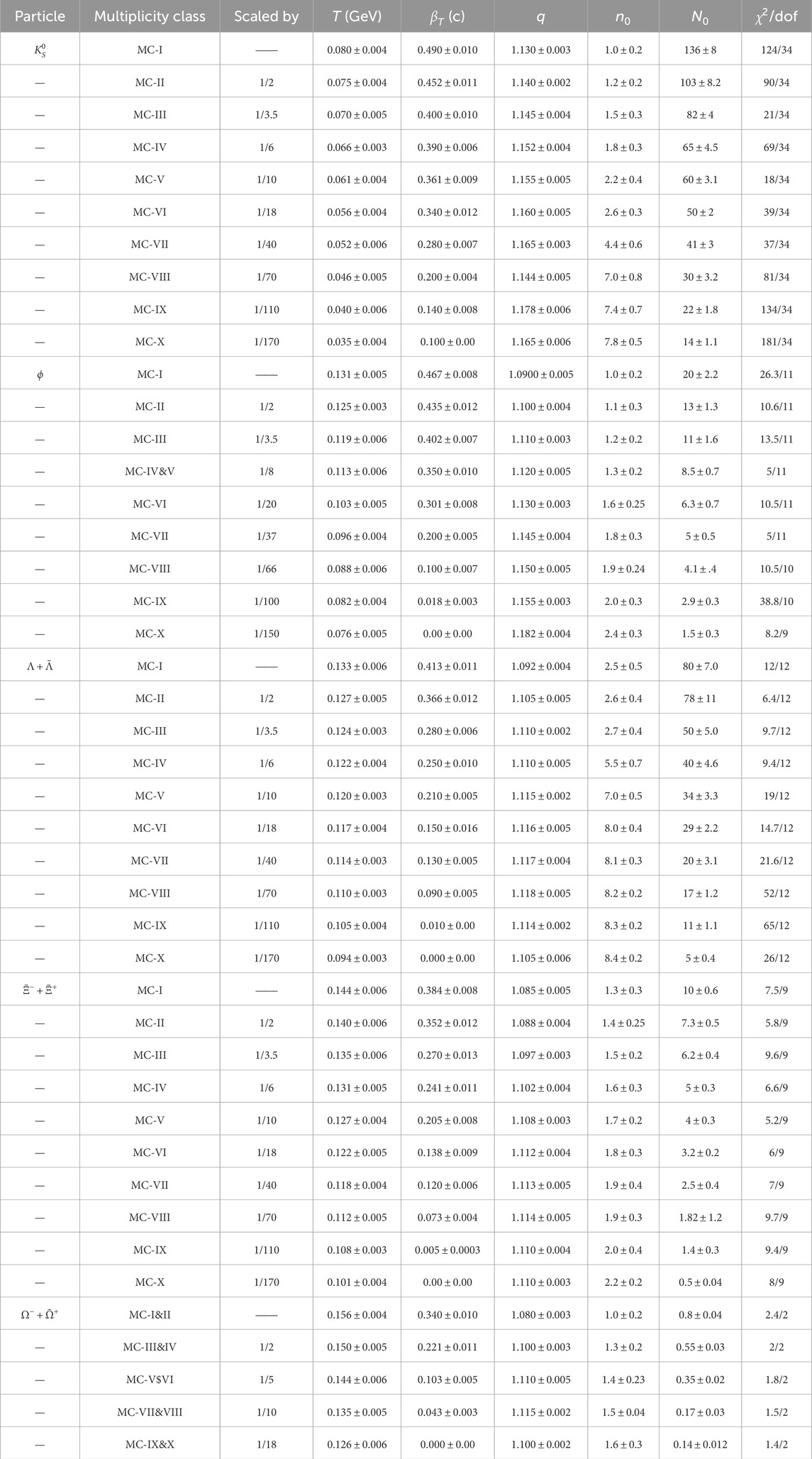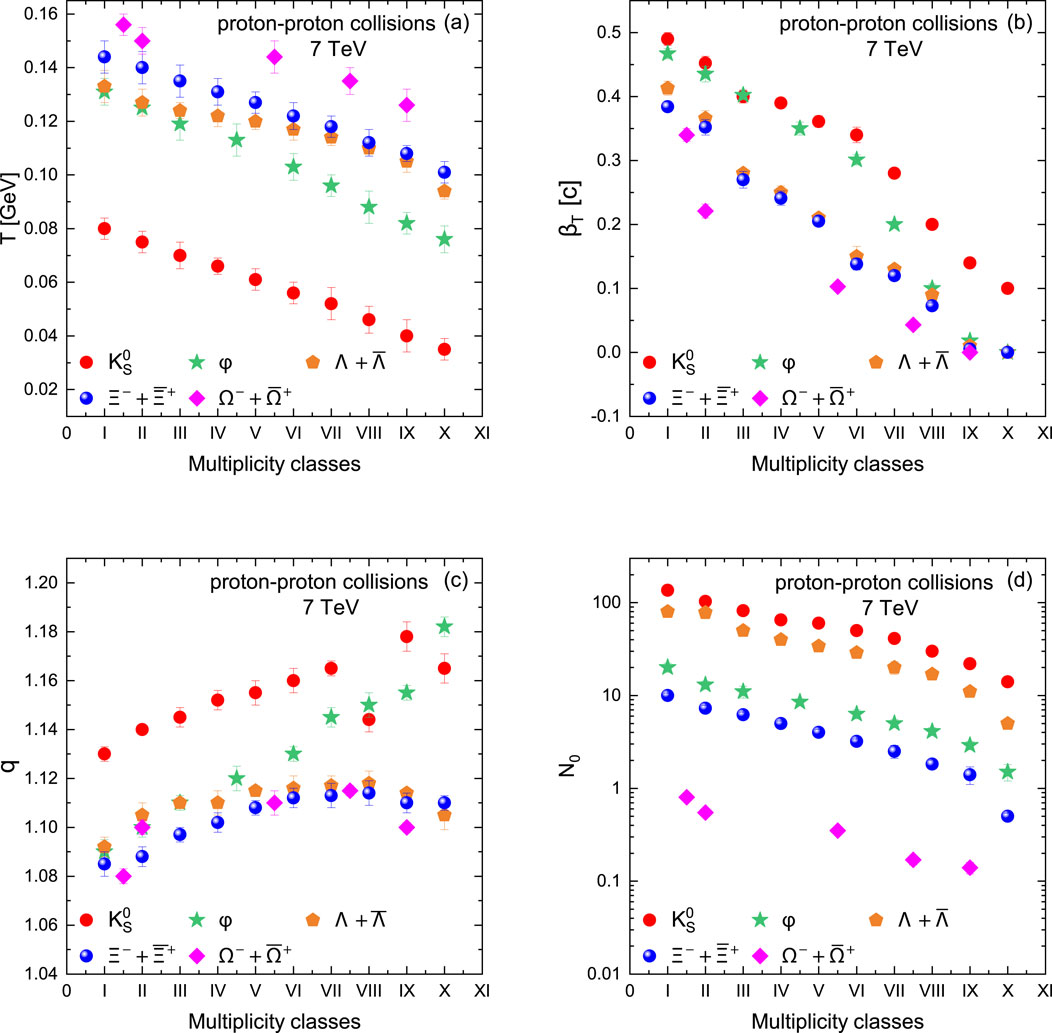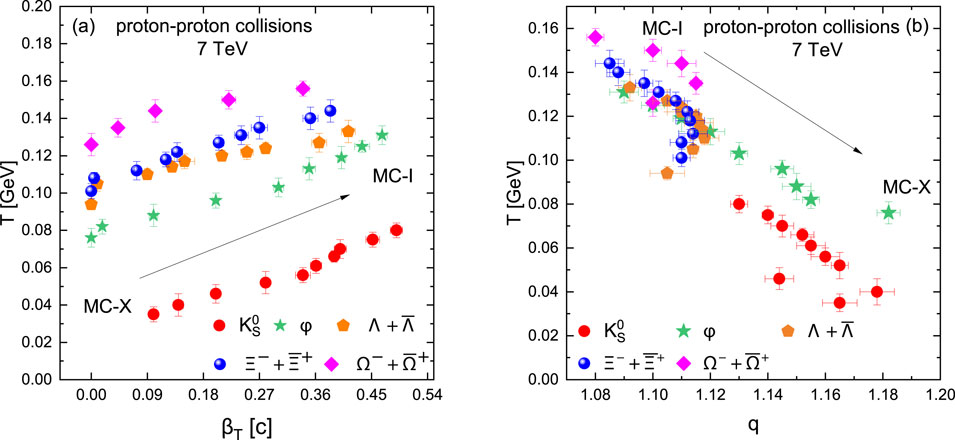- 1Institute of Theoretical Physics and State Key Laboratory of Quantum Optics and Quantum Optics Devices, Shanxi University, Taiyuan, Shanxi, China
- 2School of Mathematics, Physics and Optoelectronic Engineering, Hubei University of Automotive Technology, Shiyan, China
- 3Department of Physics, Abdul Wali Khan University Mardan, Mardan, Pakistan
- 4Center for Scientific Reseach and Entrepreneurship, Northern Border University, Arar, Saudi Arabia
We explore the spectra of transverse momenta of hadrons with strange quark content (
1 Introduction
Investigating the quantum chromodynamic (QCD) phase diagram is the primary aim of heavy-ion collisions at ultra-relativistic energies. The quark–gluon plasma (QGP) [1–6], which is believed to have existed shortly after the Big Bang, perhaps within microseconds, is a state of deconfined partons in thermal equilibrium formed by such collisions at the Large Hadron Collider (LHC) and the Relativistic Heavy Ion Collider (RHIC). Small collision systems, such as proton–proton (pp) as well as proton–nucleus (p-A) collisions, have traditionally been considered as baselines to probe heavy-ion collisions and describe the quark–gluon plasma’s (QGP) characteristics. However, recent experimental data have shown strong flow-like behavior in high multiplicity collisions of pp and p-A at LHC energies, displaying qualitative similarities to phenomena seen in collisions with heavy ions [7–14]. These observations include long-range two-particle angular correlations [10, 14, 15], non-zero second-order Fourier coefficients
Three types of temperatures are often studied in the literature of high energy collisions, which occur at different stages in the system evolution. Temperature is, of course, very crucial in the study of QGP. The three temperatures include 1) The initial temperature, which occurs at the initial stages of a collision; 2) the chemical freezeout temperature, which happens at the point of chemical freezeout; and 3) the kinetic freezeout temperature, which occurs at the kinetic freezeout stage. Particles stop colliding in an elastic manner, no new particles are created, and the yields of each type of particle become fixed during the chemical freezeout stage. Currently, the baryon chemical potential and chemical freezeout temperature are extracted using many available thermodynamics models [3, 19–21]. The kinetic freezeout occurs later than the chemical freezeout during system evolution. As the system evolves, it undergoes continuous expansion. When the system expands further and reaches the kinetic freezeout stage, the spacing between the particles widens, and the elastic collisions between them stop. Following this phase, particles begin to propagate in the direction of the detector as their momenta also become fixed. The collision system’s transverse excitation degree (in the form of temperature) and dynamic expansion (in the form of transverse flow velocity
The structure of the paper is as follows: Section 2 outlines the methodology and formalism, while Section 3 presents the results and discussion. Finally, Section 4 provides a summary of the key findings and conclusions.
2 The method and formalism
The extraction of the thermodynamic parameters through different statistical distributions and thermodynamical models has been used in recent decades. These models have been distributed in two categories. Some of them are used in case of soft excitation process, where they can cover the low
The blast wave model with Tsallis distribution will be employed, where it fits the current work’s
The terms
3 Results and discussion
This section examines the results of the
Figure 1 presents the

Figure 1. Transverse momentum spectra of strange hadrons (

Table 1. Values of
We have extracted
Figure 2C displays the dynamics of
Figure 3 displays the correlation among the parameters. Panel (a) in Figure 3 presents the correlation between
4 Conclusion
We studied the freezeout properties of strange particles produced in proton–proton collisions at
We observed that the parameter
Data availability statement
The datasets presented in this study can be found in online repositories. The names of the repository/repositories and accession number(s) can be found below: hep data.
Author contributions
HA: software and writing–original draft. HZ: funding acquisition, supervision, validation, and writing–review and editing. F-HL: conceptualization, methodology, resources, supervision, and writing–review and editing. MW: conceptualization, investigation, methodology, supervision, validation, and writing–review and editing. MB: data curation, formal analysis, methodology, resources, validation, and writing–review and editing. RG: conceptualization, data curation, investigation, project administration, resources, visualization, and writing–review and editing.
Funding
The author(s) declare that financial support was received for the research, authorship, and/or publication of this article. This work is supported by the National Natural Science Foundation of China (Grant No. 11875039), the Research Project Supported by Shanxi Scholarship Council of China (Grant No. 2023-033 and 2022-033 and 2022-014), and the Fundamental Research Program of Shanxi Province (Grant No. 202303021221071). The authors also extend their appreciation to the Deanship of Scientific Research at Northern Border University, Arar, KSA for funding this research work through the project number “NBU-FFR-2024-2461-10”.
Conflict of interest
The authors declare that the research was conducted in the absence of any commercial or financial relationships that could be construed as a potential conflict of interest.
Generative AI statement
The author(s) declare that no generative AI was used in the creation of this manuscript.
Publisher’s note
All claims expressed in this article are solely those of the authors and do not necessarily represent those of their affiliated organizations, or those of the publisher, the editors, and the reviewers. Any product that may be evaluated in this article, or claim that may be made by its manufacturer, is not guaranteed or endorsed by the publisher.
References
1. Adcoxbe K, Adlere SS, Afanasievt S, Aidalae C, Ajitanandaw NN, Akibaw Y PHENIX. Nucl Phys A (2005) 757:184–283. doi:10.1016/j.nuclphysa.2005.03.086[arXiv:nucl-ex/0410003
2. Backa BB, Bakerb MD, Ballintijnd M PHOBOS. Nucl Phys A (2005) 757:28–101. doi:10.1016/j.nuclphysa.2005.03.084[arXiv:nucl-ex/0410022
3. Adam J, Aggarwal MM, Ahammed Z, Amonett J, Anderson BD, Arkhipkin D STAR. Nucl Phys A (2005) 757:102–83. doi:10.1016/j.nuclphysa.2005.03.085[arXiv:nucl-ex/0501009
6. Shuryak EV. Theory and phenomenology of the QCD vacuum. Phys Rept (1984) 115:151–314. doi:10.1016/0370-1573(84)90037-1
7. Abelev B, Adam J, Adamová D, Adare AM, Aggarwal MM, Aglieri Rinella G, et al. Transverse sphericity of primary charged particles in minimum bias proton–proton collisions at s√ = 0.9, 2.76 and 7 TeV. Eur Phys J C (2012) 72:2124. doi:10.1140/epjc/s10052-012-2124-9
8. Chatrchyan S, Khachatryan V, Sirunyan A, Tumasyan A, Adam W, Aguilo E, et al. Observation of long-range, near-side angular correlations in pPb collisions at the LHC. Phys Lett B (2013) 718:795–814. doi:10.1016/j.physletb.2012.11.025
9. Chatrchyan S, Khachatryan V, Sirunyan AM, Tumasyan A, Adam W, Bergauer T, et al. >Study of the production of charged pions, kaons, and protons in pPb collisions at sqrt(sNN) = 5.02 TeV. Eur Phys J C (2014) 74(6):2847. doi:10.1140/epjc/s10052-014-2847-x
10. Abelev B, Adam J, Adamova D, Adare AM, Aggarwal M, Aglieri Rinella G, et al. ALICE. Phys Lett B (2013) 719:29–41. doi:10.1016/j.physletb.2013.01.012
11. Adare A, Afanasiev S, Aidala C, Ajitanand NN, Akiba Y, Al-Bataineh H, et al. PHENIX. Phys Rev C (2013) 88(2):024906. doi:10.1103/PhysRevC.88.024906
12. Adam J, Adamová D, Aggarwal M, Aglieri Rinella G, Agnello M, Agrawal N, et al. ALICE. Phys Lett B (2016) 758:389–401. doi:10.1016/j.physletb.2016.05.027
13. Acharya S, Adamová D, Adhya S, Adler A, Adolfsson J, Aggarwal M, et al. ALICE. Phys Rev Lett (2019) 123(14):142301. doi:10.1103/PhysRevLett.123.142301
14. Hirono Y, Kharzeev DE, Yin Y ATLAS. Phys Rev Lett (2016) 116(17):172301. doi:10.1103/PhysRevLett.116.172301[arXiv:1509.04776
16. Khachatryan V, Sirunyan A, Tumasyan A, Adam W, Bergauer T, Dragicevic M, et al. CMS. Phys Rev Lett (2015) 115(1):012301. doi:10.1103/PhysRevLett.115.012301
17. Acharya S, Acosta FT, Adamová D, Adler A, Adolfsson J, Aggarwal MM, et al. ALICE. Phys Rev C (2019) 99(2):024906. doi:10.1103/PhysRevC.99.024906
19. Adamczyk L, Adkins JK, Agakishiev G, Aggarwal MM, Ahammed Z, Ajitanand NN, et al. Bulk properties of the medium produced in relativistic heavy-ion collisions from the beam energy scan program. Phys Rev C (2017) 96(4):044904. doi:10.1103/PhysRevC.96.044904
20. Andronic A, Beutler F, Braun-Munzinger P, Redlich K, Stachel J. Phys Lett B (2009) 675:312–8. doi:10.1016/j.physletb.2009.04.024
21. Wheaton S, Cleymans J, Hauer M. THERMUS—a thermal model package for ROOT. Comput Phys Commun (2009) 180:84–106. doi:10.1016/j.cpc.2008.08.001
22. Schnedermann E, Sollfrank J, Heinz UW. Phys Rev C (1993) 48:2462–75. doi:10.1103/PhysRevC.48.2462[arXiv:nucl-th/9307020
23. Abelev BI, Aggarwal MM, Ahammed Z, Anderson BD, Arkhipkin D, Averichev GS STAR. Phys Rev C (2009) 79:034909. doi:10.1103/PhysRevC.79.034909[arXiv:0808
24. Mishra AN, Paić G, Pajares C, Scharenberg RP, Srivastava BK. Exploring the QGP phase above the deconfinement temperature in pp and A − A collisions at LHC energies. Nucl Phys A (2024) 1046:122865. doi:10.1016/j.nuclphysa.2024.122865
26. Tawfik AN, Maher M, El-Kateb AH, Abdelaziz S. Adv High Energy Phys. (2020):2453476. doi:10.1155/2020/2453476
27. He XW, Wei HR, Hong BH, Wu HY, Zhu WT, Wu FM. Centrality-dependent chemical potentials of light hadrons and quarks based on pT spectrum and particle yield ratio in Au-Au collisions at RHIC energies. Universe (2022) 8(8):420. doi:10.3390/universe8080420
28. Wang Q, Liu FH, Olimov KK. Excitation functions of related temperatures of η and η0 emission sources from squared momentum transfer spectra in high-energy collisions. Universe (2023) 9(7):342. doi:10.3390/universe9070342
29. Rafelski J, Muller B. Strangeness production in the quark-gluon Plasma. Phys Rev Lett (1982) 48:1066–9. doi:10.1103/PhysRevLett.48.1066
30. Chung P, Ajitanand NN, Alexander JM, Anderson M, Best D, Brady FP, et al. E895. Phys Rev Lett (2003) 91:202301. doi:10.1103/PhysRevLett.91.202301
31. Abelev BB, Adam J, Adamová D, Adare AM, Aggarwal MM, Aglieri Rinella G, et al. K(S)0 and Λ production in Pb-Pb collisions at √(s(NN))=2.76 TeV. Phys Rev Lett (2013) 111:222301. doi:10.1103/PhysRevLett.111.222301
32. Albergo S, Bellwied R, Bennett M, Boemi D, Bonner B, Caines H, et al. Lambda spectra in 11.6A GeV/c Au-Au collisions. Phys Rev Lett (2002) 88:062301. doi:10.1103/PhysRevLett.88.062301
33. Adcox K, Adler SS, Ajitanand NN, Akiba Y, Alexander J, Aphecetche L, et al. Measurement of Lambda and Lambda(macro) particles in Au+Au collisions at the square root of S(NN) = 130 GeV. Phys Rev Lett (2002) 89:092302. doi:10.1103/PhysRevLett.89.092302
34. Back BB, Betts RR, Chang J, Chang WC, Chi CY, Chu YY, et al. Antilambda production in Au+Au collisions at 11.7A GeV/c. Phys Rev Lett (2001) 87:242301. doi:10.1103/PhysRevLett.87.242301
35. Antinori F, Bacon PA, Badalà A, Barbera R, Belogianni A, Bloodworth IJ, et al. Strangeness enhancements at central rapidity in 40 A GeV/cPb–Pb collisions. J Phys G (2010) 37:045105. doi:10.1088/0954-3899/37/4/045105
37. Becattini F, Cleymans J, Keranen A, Suhonen E, Redlich K. Features of particle multiplicities and strangeness production in central heavy ion collisions between1.7Aand158A GeV/c. Phys Rev C (2001) 64:024901. doi:10.1103/PhysRevC.64.024901
38. Braun-Munzinger P, Cleymans J, Oeschler H, Redlich K. Nucl Phys A (2002) 697:902–12. doi:10.1016/S0375-9474(01)01257-X
39. Abelev BI, Aggarwal MM, Ahammed Z, Alakhverdyants AV, Anderson BD, Arkhipkin D, et al. STAR. Phys Rev C (2010) 81:024911. doi:10.1103/PhysRevC.81.024911
40. Cleymans J, Worku D. Relativistic thermodynamics: transverse momentum distributions in high-energy physics. Eur Phys J A (2012) 48:160. doi:10.1140/epja/i2012-12160-0
42. Olimov KK, Lebedev IA, Fedosimova AI, Liu FH, Dmitriyeva E, Musaev KA, et al. Correlations among parameters of the Tsallis distribution and Hagedorn function with embedded transverse flow in proton–proton collisions at (s)1/2 = 7 and 13 TeV. Eur Phys J Plus (2023) 138(5):414. doi:10.1140/epjp/s13360-023-04037-7
43. Parvan AS. Hadron transverse momentum distributions in the Tsallis statistics with escort probabilities. J Phys G (2023) 50(12):125002. doi:10.1088/1361-6471/acfe23
44. Alrebdi HI, Ajaz M, Waqas M, Ahmad MA, Maryam , Quraishi AM, et al. Chin J Phys (2024) 89:1669–77. doi:10.1016/j.cjph.2024.02.034
45. Tang Z, Xu Y, Ruan L, van Buren G, Wang F, Xu Z. Spectra and radial flow in relativistic heavy ion collisions with Tsallis statistics in a blast-wave description. Phys Rev C (2009) 79:051901. doi:10.1103/PhysRevC.79.051901
46. Waqas M, Peng G, Ajaz M, Ismail AH, Dawi E. Analyses of the collective properties of hadronic matter in Au-Au collisions at 54.4 GeV. Phys Rev D (2022) 106(7):075009. doi:10.1103/PhysRevD.106.075009
47. Khandai PK, Sett P, Shukla P, Singh V. System size dependence of hadron pT spectra in p+p and Au+Au collisions at √sNN = 200 GeV. J Phys G (2014) 41:025105. doi:10.1088/0954-3899/41/2/025105
48. Petrovici M, Andrei C, Berceanu I, Bercuci A, Herghelegiu A, Pop A. Recent results and open questions on collective type phenomena from A-A to pp collisions. AIP Conf Proc (2015) 1645(1):52–60. doi:10.1063/1.4909559
49. Olimov KK, Kanokova SZ, Olimov K, Gulamov KG, Yuldashev BS, Lutpullaev SL, et al. Average transverse expansion velocities and global freeze-out temperatures in central Cu + Cu, Au + Au, and Pb + Pb collisions at high energies at RHIC and LHC. Phys Lett A (2020) 35(14):2050115. doi:10.1142/S0217732320501151
50. Waqas M, Peng GX, Ajaz M, Haj Ismail A, Dawi EA. Analyses of the collective properties of hadronic matter in Au-Au collisions at 54.4 GeV. Phys Rev D (2022) 106(7):075009. doi:10.1103/PhysRevD.106.075009
51. Wei HR, Liu FH, Lacey RA. Kinetic freeze-out temperature and flow velocity extracted from transverse momentum spectra of final-state light flavor particles produced in collisions at RHIC and LHC. Eur Phys J A (2016) 52(4):102. doi:10.1140/epja/i2016-16102-6
52. Liu FH, Wei HR, Lacey RA. Transverse momentum and pseudorapidity distributions of final-state particles and spatial structure pictures of an interacting system in p-Pb collisions at √sNN = 5.02 TeV. Eur Phys J A (2015) 51(4):43. doi:10.1140/epja/i2015-15043-x
53. Chatterjee S, Das S, Kumar L, Mishra D, Mohanty B, Sahoo R, et al. Adv High Energy Phys. (2015) 2015:349013. doi:10.1155/2015/349013
Keywords: Tsallis temperature, transverse flow velocity, quantum chromodynamics, QGP, multiplicity
Citation: Ahmad H, Zhu H, Liu F-H, Waqas M, Badshah M and Ghodhbani R (2025) Estimation of the freezeout parameters using strange hadrons with changing multiplicity in pp collisions at 7 TeV. Front. Phys. 12:1505076. doi: 10.3389/fphy.2024.1505076
Received: 02 October 2024; Accepted: 28 November 2024;
Published: 09 January 2025.
Edited by:
Xiu-Lei Ren, Helmholtz Institute Mainz, GermanyCopyright © 2025 Ahmad, Zhu, Liu, Waqas, Badshah and Ghodhbani. This is an open-access article distributed under the terms of the Creative Commons Attribution License (CC BY). The use, distribution or reproduction in other forums is permitted, provided the original author(s) and the copyright owner(s) are credited and that the original publication in this journal is cited, in accordance with accepted academic practice. No use, distribution or reproduction is permitted which does not comply with these terms.
*Correspondence: Hailong Zhu, emh1aGxAc3h1LmVkdS5jbg==; M. Waqas, d2FxYXNfcGh5MzEzQHlhaG9vLmNvbQ==, MjAyMjAwNzNAaHVhdC5lZHUuY24=
 Hilal Ahmad
Hilal Ahmad Hailong Zhu1*
Hailong Zhu1* M. Waqas
M. Waqas Murad Badshah
Murad Badshah
